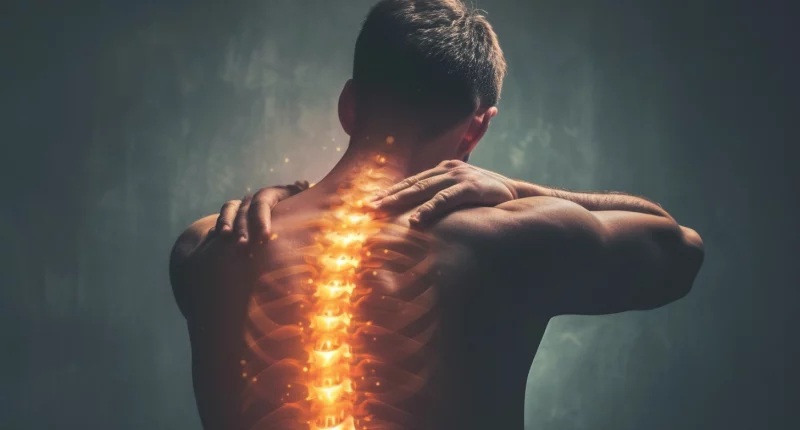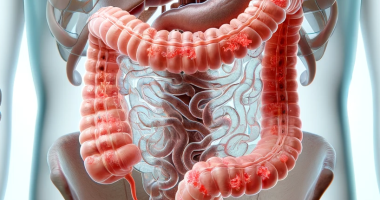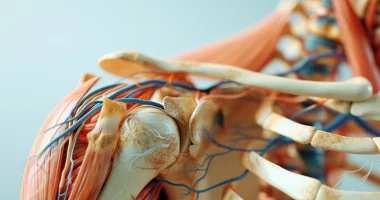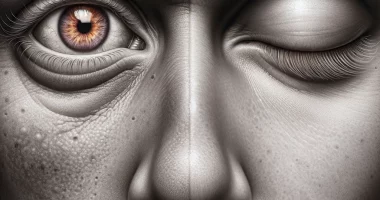Radiculopathy
What is radiculopathy?
Radiculitis, or radiculopathy, is a pathology of the peripheral part of the nervous system in which the areas of nerve fibers coming from the spinal cord (nerve roots) are pinched.
Radiculitis is a secondary pathology that develops due to nerve root compression. It is predisposed to this change in the morphology of the spinal column due to trauma, degenerative processes, etc.
The most typical symptoms of radiculitis are painful sensations along the course of nerve trunks, sensory disorders, and sometimes motor disorders. As a rule, the first signs of the disease appear acutely after exposure to an aggressor factor (unfortunate turning of the torso, trauma, etc.). However, in most cases, the pathology develops into a chronic process characterized by asymptomatic periods and a period of exacerbation with vivid manifestations that disrupt the usual way of life.
Symptoms of radiculopathy
With the progression of the pathological process, the clinical picture changes – typical symptoms appear:
- pain in the affected part of the spine, aching pain, pain increases with movement, irradiates to the limb on the affected side;
- stiffness of the periorbital muscles, which are painful on palpation;
- numbness in the legs and the feeling of crawling goosebumps;
- restriction of movement;
- rapid fatigue and decreased efficiency.
The most common is lumbosacral radiculitis due to the fact that it is this part of the spine that is under the greatest strain. In this form of the disease, pain is localized in the sacrum, lumbar region, and buttocks. The pain radiates to the lower extremity, becoming stronger when lifting the leg.
Lumbosacral radiculitis with a predominant lesion of the sciatic nerve is called sciatica. In this case, the pain spreads along the course of the involved nerve and has a typical localization – gluteal region, the posterior-external surface of the shin and thigh, and the heel.
Cervical radiculitis manifests pain in the back of the head and neck. It intensifies when turning the head, coughing, and sneezing. A protective posture appears when a person is forced to tilt his head back, thereby reducing the spasm of periorbital muscles. Often, cervical radiculitis is accompanied by symptoms of cerebral ischemia. Therefore, the patient may be bothered by dizziness, headache, and tinnitus.
With inflammation of the brachial plexus, pain is localized in the occipital and interscapular region and the shoulder. They are intensified when lifting the upper limb.
The thoracic section of the spinal column is characterized by extremely limited mobility. For this reason, the radiculitis of this part is a casuistry. In those rare cases when inflammation of the thoracic roots develops, pain is observed, which increases with inhalation-exhalation and coughing.
Causes of radiculopathy
The most common cause of radiculopathy is osteochondrosis, in which the intervertebral discs lose their elasticity and begin to squeeze the nerve roots under their weight.
The following conditions predispose to the formation of osteochondrosis:
- traumatic injuries to the spinal column in athletes, falls, impacts;
- curved posture due to incorrect sitting at a desk;
- hypodynamia;
- excessive physical exertion;
- overweight;
- endocrine disruption;
- metabolic shifts;
- impaired absorption of nutrients in the intestines.
Diagnosing radiculopathy
Objective examination methods are of great importance in establishing the diagnosis. Careful analysis of the patient’s complaints allows us to suspect radiculitis, and palpation along the nerve trunks and determination of reflexes with a neurological hammer confirms the initial conclusion.
Additional examination methods are aimed more at verifying the possible cause of radiculitis. In such patients, a radiographic examination of the involved spine is performed as a screening examination. The method allows the detection of osteochondrosis, intervertebral hernias, etc. In complex diagnostic cases, computerized and magnetic resonance imaging is performed.
As a rule, standard general clinical blood and urine tests do not reveal any abnormalities. The number of leukocytes may be elevated if the inflammatory process is active.
Treatment of radiculopathy
Treatment of radiculopathy is primarily aimed at controlling the pain syndrome. For this purpose, doctors prescribe non-steroidal anti-inflammatory drugs. These drugs have specific contraindications, so only a specialist will be able to choose a safe and effective remedy. Stronger anti-inflammatory medications are indicated in severe cases – analogs of adrenal cortex hormones. Neurologists can also perform blockades with local anesthetics.
After the pain syndrome subsides, physiotherapeutic procedures are indicated, which improve the perfusion of the nerve root.
As part of complex therapy, measures are taken to eliminate the risk factors leading to the development of radicular syndrome. Patients with obesity need to reduce body weight – for this purpose, a diet and sports training program is developed. Unique corrective corsets are recommended in the presence of posture curvature, etc.
Patients should work on strengthening the muscles surrounding the spine during the remission period. For this purpose, therapeutic exercise, according to an individualized plan, swimming, aqua aerobics, gentle massage, etc., is recommended.
Surgical treatment
Several types of surgical procedures can be performed, depending on the underlying cause of radiculopathy and the specific condition of the patient:
- Discectomy: This procedure involves the removal of a portion of a herniated disc that is pressing on a nerve root. It can be performed using a minimally invasive approach that reduces recovery time and the risk of complications.
- Laminectomy: In this procedure, part of the vertebral bone (the lamina) or bone spurs that are compressing the nerve root are removed. This surgery is often performed in cases of spinal stenosis.
- Foraminotomy: This surgery enlarges the vertebral foramen (the opening where nerve roots exit the spine) to relieve nerve compression. It can be performed alone or alongside a discectomy or laminectomy.
- Spinal Fusion: If radiculopathy is caused by instability or degeneration of the spine, a spinal fusion may be recommended to stabilize the affected section. This procedure involves joining two or more vertebrae together, sometimes using bone grafts and metal hardware.
All these treatment options are available in more than 800 hospitals worldwide (https://doctor.global/results/diseases/radiculopathy). For example, microdiscectomy is performed in 18 clinics across Turkey for an approximate price of $6.6 K (https://doctor.global/results/asia/turkey/all-cities/all-specializations/procedures/microdiscectomy).
Preventive Measures
Preventive strategies for radiculopathy focus on maintaining a healthy spine. These include regular exercise, weight management, proper lifting techniques, and maintaining good posture. Ergonomic adjustments at work and home can reduce the risk of nerve compression.




